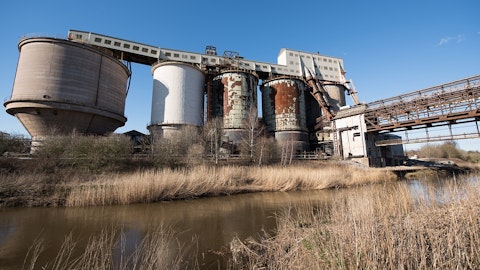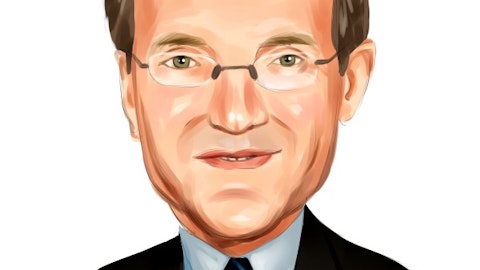Pedro Freitas: Hi, Gabriel. All right. So, with regard to the additional 1 billion, half of that comes from this cavity balance and I’ll explain in more detail. And then we have 25% approximately that comes from the fact that we had to halt operations in that region after the Cavity number 18 event, and that was halted for two months. So that’s approximately 500 billion that are cavities and 250 approximately are due to downtime. And then we have a number of other knock-on effects, smaller adjustments, legal costs, and other things that add up. Now about the cavities. In our presentation, we have a slide that talks about closing and monitoring the wells. We used to have — actually, we had four categories on that slide. One was the backfilling with sand.
Second was natural filling. One was the plugging and pressurization and the fourth category was monitoring. Now in that monitoring category, we had 6 cavities. What that means is there was an assessment made by international specialists whom we hired. And those 6 cavities were stable. They were located in regions that are geologically stable and but would not make sense to fill those cavities because the risk of a sinkhole occurring, which is what happened in cavity 18 that was a very remote risk. And for the recommendation for those cavities was that they could be monitored. And if they’re stable, then they’re stable. We don’t need to do anything because the regions [indiscernible]. Let’s say, it gives us that place of comfort. Now what happened was cavity 18 occurred and so the valuation that we arrived at with the specialists was as follows.
Well, an event occurred that was a remote possibility and everything had already been mitigated, but people had been relocated already, but it occurred nonetheless. So, the decision then was to move those 6 cabinets to natural filling because it was a remote likelihood, but it occurred anyway. So that — those cavities could still have some risk even though it may be remote. So, the perception of risk came — and so it was a decision, an internal decision that was not enforced by anyone. It was a decision that we arrived at. We decided to fill it. And of course, we announced the decision to all the federal entities and this is still being reviewed by the A&M entity. It has been filed. All the paper work has been filed, but we are still waiting for that — that protocol to be moved on.
So, we had those cavities. We had six that were naturally filled. We had 2 cavities that were removed. The first was moved to the pressurization group because it was pressurized. And last one was, cavity number 18, and it was filled as well. You’ll see in the slide that there are some cavities that are already completed, 17 of the 35, 10 are still in the confirmation phase. We have Cavity number 18 in the filling phase, the studies — the initial studies are already published, but it needs to be validated by the A&M. So, we don’t yet consider it to be fully complete. And we have 9 cavities that have been plugged and where we still need to install that gets a meter to measure the pressurization to confirm that the cavities have been pressurized so that we can consider them to be complete.
So essentially, today, you asked us what is in the future and what can change well, we have eliminated that monitoring category. I think that’s the main point. And what we have now before us is to complete the backfilling work, that’s going to take us until 2026. Today, we have 8 cavities, of which 2 are being filled and 6 have been included just now, and so they’re underway. And we have 9 or 10 other cavities that are in the confirmation phase. So, if they’re confirmed, then there’s nothing else that needs to be done for them. So as far as confirming where that provision came from? And I mean, that’s the answer. Now with regard to cash in Alagoas, you’ll see that we’ve provisioned, 5.2 billion and approximately half of that is going to be spent this year.
We also have some obligations we need to pay. And so, what we’re actually going to disperse is a little bit more than half of the 5.2 billion, which is 2.6 billion. So effective spend is going to be a little bit higher than that. Because we have working cash there as well. This is — these falls under accounts payable. And with regard to leveraging, it really depends on the EBITDA number and how you are looking at that, but we closed the year with 8.12-time leverage and our expectation for the end of the year is to reduce leveraging. And that’s a result of cash use and EBITDA. So that’s our expectation, our forecast. There is some math that Rosana showed me where it looks like leveraging is going to be approximately 4.5 times if we consider EBITDA to be $1.2 billion, which is still lower than the low cycle.
In 2019, we had a low cycle where our EBITDA was $1.6 billion without Green PE and without delta. But if we consider those two elements, the low cycle would actually be closer to $2 billion. And now — looking forward, our projection or projected mean EBITDA for the cycle. One way to do that math is to look at the past. If we look at the previous cycle, our mean EBITDA was from the order of $2.7 million, but we did not yet have that new PP plant in the U.S. nor did we have Green PE. And Mexico was operating at a very low level. So, if we include those corrections, I would say that today, Braskem, including Braskem Idesa, Braskem total would be in the order of $3 billion, maybe a little bit less, between $2.8 billion to $3 billion. I think that’s a reasonable estimate for mean EBITDA in our cycle.
The numbers that we’re working with is in the order of $3 billion.
Operator: Our next question comes from Matias Vammalle with Bluebay. You may proceed, sir.
Matias Vammalle: Thank you very much. My question has been answered. Thank you.
Operator: Our next question comes from Alejandra [indiscernible] JPM. You may proceed, sir.



